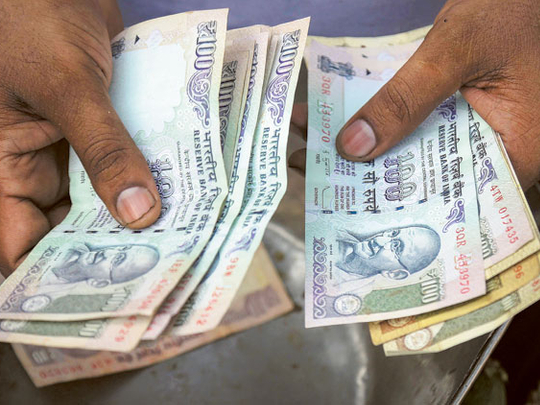
Dubai: The Indian rupee slipped further on Monday signalling that the government’s latest efforts to defend the falling currency since the beginning of this year have failed to impress the markets.
The currency once again breached the 72-mark to hit a low of 72.69 (intra-day) against the US dollar and closed at 19.72 against the dirham on Monday.
The rupee fell nearly 12 per cent year to date prompting the government and the central bank to take some short-term measures to stem the currency.
The government on Friday announced several steps to lift the rupee through better capital inflows and curbing of non-essential imports.
any action that govt or RBI takes to defend the Rupee cannot be seen as knee jerk. because that will be interpreted as panic, leading to panic selling, leading to more panic.
— Ajit Ranade (@ajit_ranade) September 11, 2018
also decrease in oil tax will displease deficit hawks and FPI's waiting for a cue for selloff of bonds.
It also pledged to stick to fiscal deficit targets.
Strengthening of the US dollar in recent months and rising oil prices have contributed to the fast decline of rupee this year.
Result of the 13-day Variable Rate Repo Auction held on September 18, 2018https://t.co/B2txgS3ddg
— ReserveBankOfIndia (@RBI) September 18, 2018
The dollar has risen against a basket of major global currencies this year.
A further lift in the dollar is anticipated as markets await news on the implementation of US tariffs on an additional $200 billion (Dh734 billion) of Chinese imports.
The latest US employment data showed unemployment rate is edging down to 3.8 per cent, matching an 18-year low.
As it stands, the priced-in probability of a fourth rate hike in 2018 stands at 61.4 per cent, leaving room for an upshift in conviction to boost the dollar.
Analysts say economic data is clearly pointing to more trouble for emerging markets currencies including the rupee in the weeks ahead.
“September has started with a bang with emerging market currencies, commodities and stocks all selling off. More fireworks could be on the way,” said Fawad Razaqzada, market analyst at Forex.com.
While a large number of external factors have been contributing to the weakness of the rupee, analysts said weak domestic economic fundamentals have dragged down investor confidence in the currency.
“Large current account deficits, high inflation, excessive external borrowing or over-valued exchange rates create a vulnerability that can be exposed when rising US interest rates create uncertainties over access to funding. This has been the story for many emerging markets crises in the past, where financial markets differentiated relatively efficiently,” Bank of Singapore said in a note.
RBI intervention
The latest round of policy intervention by the government follows limited market intervention by the Reserve Bank of India (RBI).
As of end of March, the total forex reserves of the RBI stood at $424 billion. By August, the amount had fallen to $400 billion. Latest data shows forex reserves have since fallen further indicating the RBIs efforts to hold up the value of the rupee has been a futile exercise resulting in significant erosion in forex reserves.
Government policy measures announced on last Friday target to reduce current account deficits by curbing non-essential imports and encouraging exports.
The short-term impact of these measures, according to analysts will be limited as crude oil consists of nearly 30 per cent of total imports in the last (June) quarter with engineering goods 18 per cent, chemicals and related products 10 per cent that are key manufacturing inputs. Curbs on imports of these will hurt manufacturing, value addition and exports.
While items such as gold jewellery and electronics are likely to become targets for both quantitative and tariff restrictions to curb imports, these could trigger international accusations of protectionism.
Some of the measures targeted at improving capital inflow into the country are seen too weak to make any material impact in the short-run as the overall sentiment towards emerging market currencies and asset classes remain negative.
Analysts say policy measures (to ease access to forex) such as short-term external commercial borrowings by corporates and relaxation of hedging rules for infrastructure loans are likely to be too risky and the country may be eventually sleep walk into a deeper current account crisis.
While the recent policy efforts to support rupee may be insufficient, the government and the RBI have the option to resort to some of the tried and tested measures such as issuance of non-resident Indian (NRI) bonds to increase forex inflows and tightening of interest rates to sterilise rupee liquidity.









